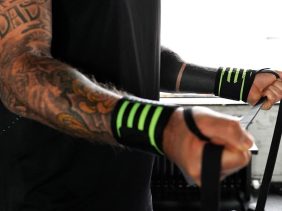Power Napping in 4 Easy Steps
 ©Westend61
©Westend61
We dreaded nap time as kids, but now we’d do anything to get it back. With a power nap, you can quickly refuel for the rest of the day. Let’s explain why taking a short nap boosts your overall health and cognitive performance and how you can best use this napping technique.
What does power napping mean?
We all know about naps, but what exactly is a ‘power nap’? A power nap is a short snooze during the day to recharge your batteries. It’s not a proper sleep, but rather just a short nod. Experts believe that a maximum of half an hour is the optimal duration for power napping. Once you have mastered this technique, you will feel fresh and alert.
Our natural biorhythm is tuned in such a way that we can work most effectively around 11 a.m. and usually are our most tired at 1 p.m. Then, in the afternoon, our energy picks back up. Lunchtime drowsiness is just a part of our nature, whether or not we get enough hours of sleep at night.
Our tip: If you don’t have much time, our Sparkling Energy Water can give you the necessary energy kick naturally with guarana, ginseng, and mate, and without any additives or artificial sweeteners.

How do I take a power nap?
All you need to do for a restful nap is to lie down or sit comfortably and fall asleep, but this is often easier said than done. If you’ve ever tried it, you might know the problem: sometimes a few minutes simply don’t feel like enough, so you ignore the alarm and just keep sleeping. But that defeats the point of the power nap because when you sleep too long, you’ll wake up more tired than you were before. Fortunately, anyone can learn the art of the proper power nap.
4 steps to restful sleep
To ensure that your nap does not go on too long, you should consider a few simple guidelines. With these 4 steps, you can master this trick and get the most out of every wink:
Step 1: Create the right environment.
Whether at home, in the office or at the airport –- theoretically, you can take a power nap anywhere. However, the right atmosphere will help you to fall asleep faster and to rest more efficiently during a short period of time.
For this, find a quiet place where you can close your eyes for a few minutes without being disturbed. It’s really important that nobody disturbs your daytime naps! Sit or lie down comfortably and put your head somewhere. An office chair is fine if you can sit comfortably and put your head on your arms. Also, make sure that you are not too cold or warm.
Step 2: Decide the right duration
The optimal power nap duration is very important. The rule here is: brevity is the key. According to Jürgen Zulley, Professor of Biological Psychology at the University of Regensburg, a power nap should last between 10 minutes and half an hour to best feel its benefits. But if you are just starting to get the hang of it, you can go a little longer. The goal, however, is to feel as rested after a short nap as you would after an hour of sleep.
To avoid sleeping too long, set an alarm clock with a gentle wake-up tone. Even if it’s hard, you should really try to wake up as soon as the alarm rings and not just go back to sleep. You will notice that after a few power naps you will wake up on your own after a short time.
Step 3: Find a comfortable pillow
It’s important, especially in the beginning, that you can lie or sit comfortably. You should lay your head down gently so you can relax and avoid neck pain. So, if you are napping in an office chair, make sure that your head can’t fall to the side.
Although a soft pillow would be ideal, you don’t always have a pillow at hand just when you want to take a nap. In these cases, a little creativity goes a long way. A jacket, a scarf, or even a backpack can easily replace a conventional pillow. And if it’s comfortable, you can also simply rest your head on your arms.
Step 4: Effective techniques for falling asleep quickly
So you’ve created the perfect environment for yourself, you’ve fluffed up your pillow again, you’re tired, and still can’t fall asleep? This is a common problem because, despite seemingly optimal conditions, most people cannot fall asleep at the touch of a button. We either have a thousand thoughts going through our heads or it suddenly feels like we have itches we must scratch. But don’t worry – you can teach your body to deliberately come to rest and slide into sleep! Relaxation techniques such as progressive muscle relaxation or breathing exercises will help you do this. And the right food will also help you fall asleep as well.
The easiest way to relax is to lie on your back and stretch your arms and legs. But you can also sit down comfortably. Close your eyes. Take a deep breath through your nose, hold it for about 4 – 7 seconds and then breathe out through your mouth or nose. Repeat this simple breathing technique a few times. Before you know it, you might doze off or at least be much calmer.
Our tip: Whether you need to get up in the morning or to relax in the evening – in our All-Day Vitality Tea Set you will find the right tea for every everyday situation. Melissa and lavender will help you to calm down in the evening and ease into sleep relaxed.
How long should a power nap be?
How long the nap should last is up to each individual. Ideally, you should nap for only a short time, no longer than an hour. If you doze off for several hours, you risk being even more tired than before. On weekends, however, a long nap has its advantages.
10 – 20 minutes
If you can manage to nod away continuously for about 20 minutes, you are in the light sleep phase. When you wake up, you will be fresh and rested and will have no problems getting up. This short period of time is ideal for closing your eyes from time to time.
30 minutes
From around 30 minutes, you fall into deeper sleep phases. Many people do not wake up quite as rested during those phases. As a result, half an hour can be too long. So if you notice that you do not jump out of your bed as light as a feather after half an hour, try to switch to a short nap duration.
60 minutes
Although you can’t really call an hour a power nap, the benefits of a 60-minute nap are definitely worthwhile. During this time you sink into deep sleep and can store newly learned information particularly well. Longer naps are ideal on weekends in particular.
90 minutes
After a 90-minute nap you will go through a full sleep cycle including a phase of REM sleep. This means that your body starts to dream and stores newly acquired knowledge. When you wake up after 1 ½ hours of REM sleep, you will feel rested and awake. Taking a longer nap is not something you should do in the late afternoon, however, or it might be harder to get to sleep at night. If this is the case, these 7 tips for restful sleep will help you.
Is power napping healthy?
Everyone who has ever taken a nap knows the relaxing effect of a quick shuteye during the day. But research has also proven that power napping can increase performance by up to 35 percent. This is partly due to our natural biorhythm. It is quite normal for us to become tired in the afternoon. According to Dr. Martin Braun from the Fraunhofer Institute for Industrial Engineering, the time after lunch between 12 and 2 p.m. is ideal for taking a power nap. It’ s during this time of day that we are least productive and have a natural need for sleep. Try taking a nap then. Your body will thank you for it.
If taking a nap is out of the question for you, just closing your eyes and resting for a short time will help relax you. So the next time you’re feeling yourself fade at your workplace, give yourself a moment to close your eyes and do nothing. You will notice that you will feel somewhat recovered afterward, and able to tackle the second half of the day productively.
Our summary
- A power nap is a short nap to boost your energy level.
- The optimal duration for the nap is between 10 minutes and half an hour. Avoid sleeping too long. Anything much longer will have exactly the opposite effect and might make you even more tired afterward.
- Sleeping only briefly can be difficult in the beginning. But with the right technique, you can quickly reap the benefits from the advantages of power napping. Find a quiet place, sit or lie down comfortably and breathe in and out deeply and calmly, and last but certainly not least, enjoy your nap time.
Sources for this article
We at foodspring use only high-quality sources, including peer-reviewed studies, to support the facts within our articles. Read our editorial policy to learn more about how we fact-check and keep our content accurate, reliable, and trustworthy.
- Ärztezeitung (2004): Ausgeschlafen zum Erfolg – durch Powernapping, unter: https://www.aerztezeitung.de/Medizin/Ausgeschlafen-zum-Erfolg-durch-Powernapping-325162.html [Stand: April 2020].





























